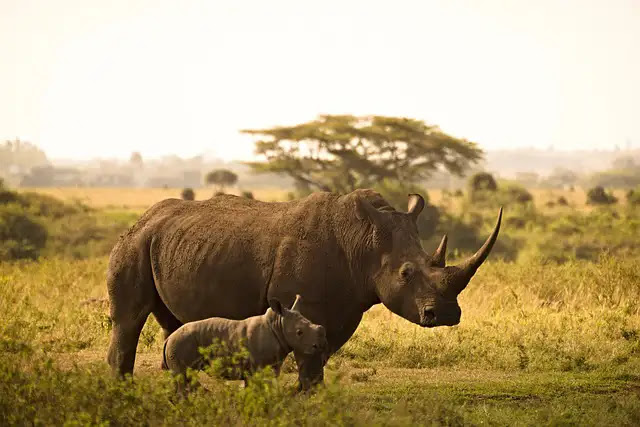Rhinoceros are fascinating creatures that have captured the attention of people for centuries. With their distinctive horns and armored skin, they are one of the most unique and recognizable animals on the planet. However, they are also one of the most endangered, with many species facing extinction due to habitat loss and poaching. In this article, we'll explore 50 facts about rhinoceros, from their diet and behavior to their value in traditional medicine and culture.
50 Fascinating Facts about Rhinoceros: From Their Horns to Endangerment
- Rhinoceros are large herbivorous mammals found in Africa and Asia.
- They are known for their distinctive horn, which is made of keratin and is used for defense and display.
- There are five species of rhinoceros: the white rhinoceros, the black rhinoceros, the Indian rhinoceros, the Javan rhinoceros, and the Sumatran rhinoceros.
- The white rhinoceros is the largest species and can weigh up to 2.5 tons.
- Rhinoceros are social animals and live in groups called crashes.
- They are primarily active at night and spend the day resting in the shade.
- Rhinoceros have thick, armored skin that is covered in folds and wrinkles.
- Their skin is also very sensitive and they enjoy being rubbed and scratched by other rhinoceros.
- Rhinoceros have a strong sense of smell and use their sense of smell to communicate with other rhinoceros.
- They also have poor eyesight and rely on their sense of smell and hearing to detect predators.
- Rhinoceros are herbivores and primarily eat grasses and leaves.
- They can consume up to 50 kilograms of food per day.
- Rhinoceros have a three-chambered stomach that helps them digest tough plant material.
- They can go up to five days without drinking water.
- Rhinoceros are solitary animals, except for the white rhinoceros, which live in groups.
- They are highly territorial and will defend their territory against other rhinoceros.
- Rhinoceros are threatened by habitat loss and poaching for their horn.
- Rhino horns are highly valued in traditional medicine and are also used as a status symbol.
- Rhino horn is made of keratin, the same material as human hair and nails.
- The black rhinoceros is critically endangered and is one of the most endangered animals in the world.
- The Indian rhinoceros has a single horn that can grow up to 60 centimeters long.
- The Javan rhinoceros is the rarest rhinoceros species and is critically endangered.
- The Sumatran rhinoceros is the smallest rhinoceros species and is also critically endangered.
- Rhinoceros have been around for millions of years and are considered to be one of the oldest mammal groups.
- Rhinoceros can run at speeds of up to 40 kilometers per hour.
- They have poor eyesight but excellent hearing and sense of smell.
- Rhinoceros communicate with each other using a variety of sounds and body language.
- They have a prehensile upper lip that they use to grasp and pull vegetation.
- Rhinoceros are known for their aggressive behavior and can be very dangerous when provoked.
- They have few natural predators, but lions and crocodiles are known to occasionally attack them.
- The white rhinoceros is not actually white, but is named for the Afrikaans word "weit," which means wide, referring to its wide, square mouth.
- The black rhinoceros has a pointed, prehensile upper lip that it uses to grasp vegetation.
- The Indian rhinoceros has a distinctive fold of skin that looks like armor and helps protect it from predators.
- The Javan rhinoceros has a single horn that is smaller than the horns of other rhinoceros species.
- The Sumatran rhinoceros has two horns, but they are much smaller than the horns of other rhinoceros species.
- Rhinoceros have a lifespan of 35 to 50 years in the wild, and up to 60 years in captivity.
- The gestation period for rhinoceros is around 15 to 16 months.
- Rhinoceros are often hunted for their horns, which are believed to have medicinal properties in some cultures.
- In some countries, rhinoceros are also hunted for sport.
- Rhino horn is made up of tightly packed keratin fibers that grow continuously throughout the animal's life.
- Rhino horns can reach lengths of up to 1.5 meters.
- Rhino horns are worth more per gram than gold or cocaine on the black market.
- Poaching of rhinoceros has led to a sharp decline in their populations, with some species now critically endangered.
- Rhino horn is sometimes used in traditional Chinese medicine as a treatment for fever, rheumatism, and other ailments.
- The horn of a rhinoceros is also used in some cultures as a status symbol, and as a handle for daggers and other weapons.
- Rhino horns are not just valuable for their medicinal and cultural properties, but also for their ornamental value.
- Rhino horns have been used to make cups, bowls, and other decorative items for centuries.
- Many conservation organizations are working to protect rhinoceros populations and prevent poaching.
- One method used to protect rhinoceros is to remove their horns, making them less valuable to poachers.
- Another method is to increase penalties for poaching and educate the public about the importance of rhinoceros conservation.
Rhinoceros are incredible animals that deserve our attention and protection. With their powerful presence and unique characteristics, they have long captured our imaginations and inspired us to learn more about the natural world. However, with many species now critically endangered, it's more important than ever to raise awareness of their plight and work towards conservation efforts. By sharing these 50 facts about rhinoceros, we hope to inspire a greater appreciation for these magnificent creatures and encourage people to take action to protect them for generations to come.









![[100+] गौरैया के बारे में रोचक तथ्य - Facts About Sparrow in Hindi](https://blogger.googleusercontent.com/img/b/R29vZ2xl/AVvXsEjAMPNSpkqO8-9akUiPokDXHagmsQFwp-aZl-19OFI6ZL3MLknwTd6PUp3aQy9z_kWHrPvtY1aKkGV8ybbyuIuobUEPhEq-ctYtgNg56vOT3Uui-kbyp476SdBCUQ3KRj0TpAxc4H84_K79/w100/ezgif.com-gif-maker+%25281%2529.webp)




0 Comments